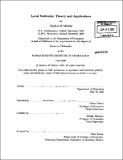| dc.contributor.advisor | Glenn Ellison and Abhijit Banerjee. | en_US |
| dc.contributor.author | Möbius, Markus M. (Markus Michael), 1971- | en_US |
| dc.contributor.other | Massachusetts Institute of Technology. Dept. of Economics. | en_US |
| dc.date.accessioned | 2006-11-07T16:42:59Z | |
| dc.date.available | 2006-11-07T16:42:59Z | |
| dc.date.copyright | 2000 | en_US |
| dc.date.issued | 2000 | en_US |
| dc.identifier.uri | http://hdl.handle.net/1721.1/34637 | |
| dc.description | Thesis (Ph.D.)--Massachusetts Institute of Technology, Dept. of Economics, 2000. | en_US |
| dc.description | Includes bibliographical references (p. 163-169). | en_US |
| dc.description.abstract | Chapter 2 analyzes a simple evolutionary model of residential segregation based on decentralized racism which extends Schelling's (1972) well-known tipping model by allowing for local interaction among residents. The richer set-up explains not only the persistence of ghettos, but also provides a mechanism for the rapid transition from an all-white to an all-black equilibrium. The analysis of the model introduces a new technique to characterize the medium and long-run stochastic dynamics of processes with many agents. Chapter 3 looks at the curious dynamics of telephone competition between AT&T and the 'Independents' at the turn of the century. Competition between these two non-interconnected networks was initially vigorous and reached its peak between 1905 and 1907 but then declined rapidly. My analysis is based on the observation that urban markets subdivide into social 'islands' along geographical and socio-economic dimensions: users are more likely to communicate with subscribers 'inside' their island than with those 'outside' it. In a simple evolutionary model I demonstrate how minority networks can thrive and preserve their market share at a low state of development but become eventually extinct as the industry matures. Chapter 4 explores why the division of labor first increased enormously during industrialization but has decreased again since the 1970s through the increased use of job rotation, flat hierarchies and autonomous work teams. This striking pattern in the organization of work can be derived in a model where (a) technology and market size determine the degree to which products are standardized and (b) more customized products are subject to trends and fashions which make production tasks less predictable and a strict division of labor impractical. The model also explains changes in the demand for skilled labor over time, predicts the rise of multi-purpose vs. single-purpose machines in advanced industrial economies, and provides a mechanism for trade between similar countries to affect wage inequality. | en_US |
| dc.description.statementofresponsibility | by Markus M. Möbius. | en_US |
| dc.format.extent | 169 p. | en_US |
| dc.format.extent | 10154866 bytes | |
| dc.format.extent | 10162040 bytes | |
| dc.format.mimetype | application/pdf | |
| dc.format.mimetype | application/pdf | |
| dc.language.iso | eng | en_US |
| dc.publisher | Massachusetts Institute of Technology | en_US |
| dc.rights | M.I.T. theses are protected by copyright. They may be viewed from this source for any purpose, but reproduction or distribution in any format is prohibited without written permission. See provided URL for inquiries about permission. | en_US |
| dc.rights.uri | http://dspace.mit.edu/handle/1721.1/7582 | |
| dc.subject | Economics. | en_US |
| dc.title | Local networks : theory and applications | en_US |
| dc.type | Thesis | en_US |
| dc.description.degree | Ph.D. | en_US |
| dc.contributor.department | Massachusetts Institute of Technology. Department of Economics | |
| dc.identifier.oclc | 47443376 | en_US |
